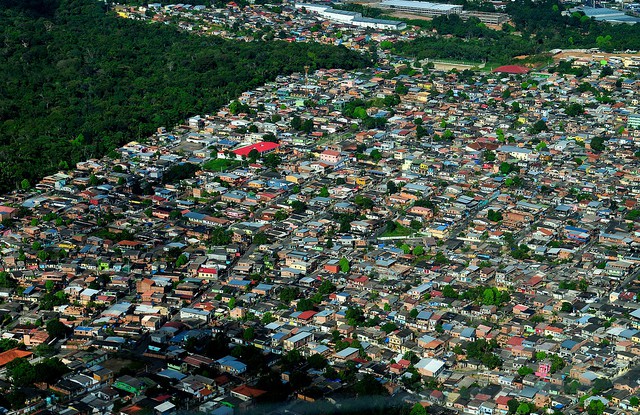
SAN JOSE, Costa Rica (7 August, 2013) – The migration of rural people to cities in the Brazilian Amazon often does not result in hoped-for poverty alleviation or biodiversity conservation, according to a professor at the University of Lancaster Environment Centre.
Rural dwellers often leave the forest and migrate to cities hoping to experience improvements in income, said Luke Parry during this year’s Association for Tropical Biology and Conservation (ATBC) meeting in San José, Costa Rica.
Rural exodus potentially benefits biodiversity because it means the amount of forest area cleared for agriculture could decrease, leading to less pressure on wildlife populations; however, according to Parry, the beneficial links to migration may not be so straightforward, nor will win-win scenarios be easily attained, at least in the Brazilian Amazon.
“Rural households that have migrated to the cities are not better off. Most migrants are still poor and uneducated — and they still consume wildlife, a lot of it,” Parry said.
Based on research to evaluate the impact of rural-to-urban migration in two small cities on the Madeira River in the Brazilian Amazon, Parry determined that migrants who left their rural homes in search of better work opportunities still lacked access to good urban employment and largely failed to escape from poverty.
Improved access to education was identified by Parry as one of the main drivers of migration to urban areas.
“They leave in search for education opportunities,” Parry said. “Migrants believe that better education will open doors to economic opportunities and improved well-being. Instead, even if access to education services is possible, incomes stayed low for rural urban migrants.”
The exodus of rural populations did not lead to improvements in terms of biodiversity either: virtually all urban households in Parry’s survey ate wildlife, including fish, bushmeat, turtles and caimans.
This consumption included endangered species. As a result, harvesting of wild species did not decrease, as Parry expected. Quite the contrary, migrants do not lose their taste for wild meats once they start their new lives in urban areas.
The urban demand for bushmeat is increasing the pressure on wildlife in rural areas. “Wilderness has become urbanized,” Parry said. “This points to a potential wild-meat crisis — or can enhance conservation and the sustainable harvesting of bushmeat in Amazonia.”
However, Parry’s conclusions contrast with research carried out by Nathalie Van Vliet, a CIFOR researcher who was also on the panel. She found opposing results in the Colombian and Brazilian Amazon: as people move into the cities, despite their preference for wild meat, they abandon wild meat consumption and replace it with cheaper chicken, eggs and other processed meats.
Parry’s findings illustrate that while not all Amazonian urban populations shift away from traditional foods, they do experience the same nutrition transition identified by Van Vliet. The most frequently consumed form of animal protein is chicken and fish, he said.
Parry’s study, which looked at the consumption (yes or no) of different species within a 12-month period, identified poverty as a strong predictor of hunting and fishing. However, while poor migrants harvested threatened primates, birds and taboo fish species, wealthier non-migrants bought threatened fishes and turtles.
The destructive impacts of rural-urban migration by farmers have also been documented in Peru and Mexico.
A CIFOR study linked the abandonment of rural areas to more frequent and intense fires in the Peruvian Amazon while research conducted in Mexico by James Robson and Fikret Berkes indicated that migration contributed to the loss of traditional management practices which in turn led to a decline in biodiversity.
According to Parry, everything points to “a perfect storm: poverty levels are high, large tracts of forests that have been abandoned are now open to further deforestation, and there is a growing demand for wild meat to supply the increasing urban populations.”
For more information about the topics discussed in this article, please contact Nathalie Van Vliet at vanvlietnathalie@yahoo.com or Miguel Pinedo-Vasquez at m.pinedo-vasquez@cgiar.org
This work forms part of the CGIAR Research Program on Forests, Trees and Agroforestry.
We want you to share Forests News content, which is licensed under Creative Commons Attribution-NonCommercial-ShareAlike 4.0 International (CC BY-NC-SA 4.0). This means you are free to redistribute our material for non-commercial purposes. All we ask is that you give Forests News appropriate credit and link to the original Forests News content, indicate if changes were made, and distribute your contributions under the same Creative Commons license. You must notify Forests News if you repost, reprint or reuse our materials by contacting forestsnews@cifor-icraf.org.